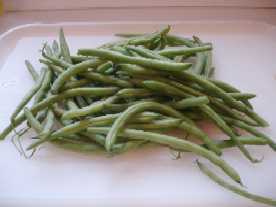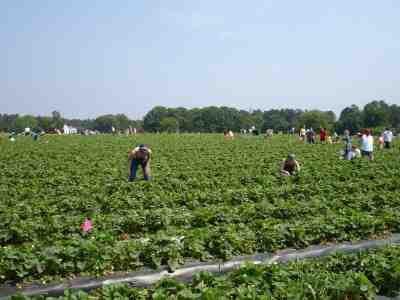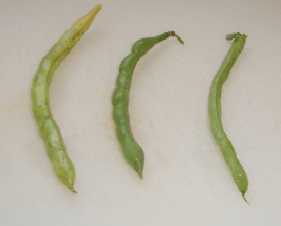
Bean U-Pick Orchards in Eastern Idaho in 2024, by county
Below are the U-Pick orchards and farms for beans that we know of in this area. Not all areas of any state, nor even every state, have beans orchards that are open to the public. If you know of any others, please tell us using the add a farm form!
Remember to always check with the farm's own website or Facebook page before you go - or call or email them if they don't have a website or Facebook page. Conditions at the farms and crops can change literally overnight, so if you want to avoid a wasted trip out there - check with the farm directly before you go! If I cannot reach them, I DON'T GO!
PLEASE report closed farms, broken links and incorrect info using the "Report Corrections" form below.
Bingham County
- Adamson Farms U-Pick - Uses natural growing practices, beans, beets, broccoli, carrots, corn (sweet), cucumbers, herbs or spices, kale, summer squash, winter squash, tomatoes, other vegetables, U-pick and already picked, picnic area, school tours
1451 N 1000 E, Shelley, ID 83274. Phone: (208) 520-0481. Email: rensons@yahoo.com. Open: July 1 to November 10 open 7:00 am to 9:00 pm;all week. Directions: Half way between Idaho Falls and Shelley, Idaho from State Highway 91 go east on Clinger Road \(1450 North\) over the railroad tracks to the end of the road \(about a mile\) where it comes to a T at 1000 East \(Stanton Road\). You will be looking at the garden on the North East corner. Early vegetables like peas, lettuce, and radishes in July; Late vegetables such as beans, cucumbers, and squash in August; Pumpkins and corn are available in late September on;. We use natural practices, but are not yet certified Organic. Payment: Cash, only. . Click here for a map and directions. Payment: Cash, only.
Adamson Farms U-Pick Facebook page. . Alternate Phone: (208) 821-5171. . Half way between Idaho Falls and Shelley, Idaho from State Highway 91 go east on Clinger Road (1450 North) over the railroad tracks to the end of the road (about a mile) where it comes to a T at 1000 East (Stanton Road). You will be looking at the garden on the North East corner. Early vegetables like peas, lettuce, and radishes in July; Late vegetables such as beans, cucumbers, and squash in August; Pumpkins and corn are available in late September on;. We use natural practices, but are not yet certified Organic. (ADDED: July 27, 2021) - Grove City Gardens - beans, beets, carrots, corn (sweet), cucumbers, herbs or spices, onions, peas, peppers, pumpkins, raspberries (red), raspberries (Spring, red), raspberries (Autumn, red), rhubarb, summer squash, winter squash, strawberries, tomatoes, porta-potties are available, events at your location (call for info)
246 Wet 200 North, Blackfoot, ID 83221. Phone: 208-403-2664. Email: richdeere@mac.com. Open: See our website for current hours; Click here for current open hours, days and dates. Directions: Highway 26 toward Arco. Turn right after the gas station. Turn right at the next stop sign. Go 1 mile and look for the signs on the left. . Click here for a map and directions. Payment: Cash, Check, Debit cards, Visa, MasterCard.
Grove City Gardens Facebook page. .
Jefferson County
- Ashland Produce - No pesticides are used, beans, peas, pumpkins,
158 North 4544 East, Rigby, ID 83442. Phone: (208) 538-6031. Email: sharlyn_a5@hotmail.com. Open: Monday to Saturday 10 am to 7 pm; Closed on Sunday Hours can vary, please check our facebook page for any updates; Typical season is from early July to end of October. Directions: From Rigby Idaho: Take Highway 48 East toward the town of Ririe. We are eight miles East of Rigby and two miles West of Ririe on Highway 48. . Click here for a map and directions. Payment: Cash, Venmo, Debit cards, Visa, MasterCard, Discover, AmEx. . Peas and new potatoes begin around Independence day or July 4; Green beans, cucumbers, beets and Summer squashes are ready about the third week in July; Sweet corn, tomatoes, peppers, onions, carrots, eggplant are in about the beginning of August; Pumpkins and winter squashes are usually ready at the end of September and are harvested through October;. We do not use pesticides on the crops. (UPDATED: August 07, 2020)
Pick Your Own Farms!
Green Bean, Lima Bean, Shelled Beans Picking Tips, Recipes and Information
When are fresh beans available?
Beans are a warm weather crop, and won't grow much in cold soil. It takes them about 60 to 70 days from seed to harvest.
In the U.S. beans typically peak in harvesting from June through October in the South, and in July to September in the North. But they can be ready as early as early June in many places, if the weather is good.
Before you leave to go to the farm:
- Always call before you go to the farm - it's hard to pick in a muddy field!
- Most growers furnish picking containers designed for beans, but they may charge you for them; be sure to call before you go to see if you need to bring containers.
- Bring something to drink and a few snacks; you'd be surprised how you can work up a thirst and appetite! And don't forget hats and sunscreen for the sun. Bugs usually aren't a problem, but some deet might be good to bring along if it has been rainy.
Tips on How to Pick Beans
Whether you pick beans from your garden or at a Pick-Your-Own farm, here are a few tips to keep in mind.
Tips on How to Pick Green Beans
- Most beans these days are "stringless". That refers to a string, tough filament of the bean that runs along the outside from one end to the other. Some beans have two, one on each side; and some have one.
- I prefer to snap the bean off the plant just below where the stem attaches to the bean. If you do this, it will save time when you get home, because one end of the bean has already been trimmed. But this only makes sense if you will be using, cooking, canning or freezing the beans that day.
- If you won't be using the beans the same day, then break off the bean from the plant along the thin stem that connects the bean to the plant.
- The beans snap off pretty easily. hence the name "snap beans".
- Pole beans are the easiest to pick, because, since they grow up poles or twine, you don't have to squat down or bend over!
- Beans are ready for harvest when the pods are plump and firm, but not yet bulging. .
- In your own garden, pick your beans regularly to encourage more growth and prevent the pods from becoming tough and stringy.
- To harvest, hold the stem of the plant with one hand and gently snap the pod with the other..
Look for string, snap or green beans that are :
-
firm

- green (not yellowish - unless you're picking yellow beans!)
- smooth, not wrinkly on the surface - that's an old or dried out bean. Snap beans are best when the pods are firm and snap readily, but before the seeds within the pod develop. The tips should be pliable
- not lumpy - those lumps are the beans that are developed - that's an overripe green bean! Of course, if you want mature beans (not including the pod) then that's a different story, but we're talking about green beans here).
-
The beans in the photo at right are, from left:
- old and yellowing,
- overripe and lumpy; and
- dried out and damaged. - Avoid placing the picked beans in the sunlight any longer than necessary. It is better to put them in the shade of a tree or shed than in the car trunk or on the car seat. Cool them as soon as possible after picking. I prefer to bring a cooler with ice in it. Green Beans may be kept fresh in the refrigerator for 3 or 4 days
When you get home
- After harvesting, store your beans in the refrigerator or blanch and freeze them for longer storage.
- Put them in the vegetable crisper in the fridge, in a loose plastic bag.
- They will be good for about a week like that.
Bean recipes and home canning
Now, get ready to can or freeze the extra beans - It is VERY easy! Click on the links for easy instructions.
- How to can green beans, yellow beans, snap beans, broad beans, etc.
- How to make pickled beans
- How to freeze green beans (and other beans)
- How to Freeze Lima Beans, Broad beans, Butter Beans and/or Pinto Beans
- Canning fresh shelled beans
- Canned dried beans and peas (from kidney beans, peas, lima beans, broadbeans, chickpeas, pole beans, etc.)
- Canned Baked Beans With Tomato or Molasses Sauce
- Canned Baked Beans With Back, Pork or Ham and Tomato or Molasses Sauce -
- Pickled green beans
- Pickled Dill beans
- Mustard beans (pickled mustard beans)
- Pickled Three-Bean Salad
Varieties
There are many different types of beans, each with their own unique flavor, texture, and growing requirements. Some of the most popular varieties include:
- Green Beans: Also known as snap beans or string beans, green beans are a classic garden staple. They can be eaten fresh or cooked and come in bush and pole varieties.
- Lima Beans: Lima beans (called Broad Beans or Butter Beans in the UK) are a nutritious and protein-rich vegetable that can be eaten fresh or dried. They require a long growing season and prefer warm temperatures.
- Pole Beans: Pole beans are a climbing variety of bean that require support to grow. They can reach up to 10 feet tall and have a longer growing season than bush beans.
- Dried Beans: Dried beans are a versatile pantry staple that can be used in soups, stews, and other dishes. Popular varieties include black beans, navy beans, kidney beans, black beans, garbanzo (aka, chick peas) and pinto beans
- s, navy beans, kidney beans, black beans, garbanzo (aka, chick peas) and pinto beans
Other Local Farm Products (Honey, Horses, Milk, Meat, Eggs, Etc.)
(NOT pick-your-own, unless they are also listed above)
- Farm markets and roadside stands
- Local Honey Finder
- Local Meat, Milk and Eggs
- Venues: Farms, Wineries, Orchards for your event, wedding or party
- Easter egg hunts
- Children"s consignment sales
- Fruit and vegetable festivals
- Winery tours and wine tastings
- Horse rides, stables, lessons, trails
- Maple Syrup farms and sugarworks
- Bed & Breakfasts on Farms, Wineries, Ranches and Orchards
- Pumpkin patches
- Corn mazes
- Zombie Paintball venues
- Christmas Tree Farms & lots
- Environmental resources
- Consumer fraud information
- Wholesale food sources
- Resources for Farmers
Looking for canning equipment and supplies?
Water bath canner with a jar rack
Pressure canners for gas, electric and induction stoves: Presto 23Qt or T-fal 22Qt
Canning scoop (this one is PERFECT)
Ball Blue book (most recent version)
Find Other types of farms:
- Easter egg hunts
- Children's consignment sales
- Farm markets and roadside stands
- Road trips and camping resources
- Local Honey, apiaries, beekeepers
- Local Meat, Milk and Eggs
- Consumer fraud and scams information
- Home canning supplies at the best prices on the internet!
- Maple Syrup Farms, sugarworks, maple syrup festivals
- Environmental information and resources
- Farms For Your Event for birthday parties, weddings, receptions, business meetings, retreats, etc.
- Festivals - local fruit and vegetable festivals
- Pumpkin patches and corn mazes
- Christmas Tree Farms and lots
Get the
most recent version of
the Ball Blue Book
Get the
most recent version of
the Ball Blue Book of Home Canning
Find other types of farms:
- Easter egg hunts
- Children's consignment sales
- Farm markets and roadside stands
- Local Honey
- Local Meat, Milk and Eggs
- Road trip and camping
- Pumpkin patches and corn mazes
- Christmas Tree Farms and lots
- Maple Syrup farms and sugarworks
Highly rated canning supplies:
- Regular Mouth Canning Lids with food-grade with BPA Free Silicone seals for Ball, Kerr Jars for Canning
- Canning accessories kit: funnel, jar tongs, lid lifter, etc
- Food Dehydrator, 400W Electric with 8 Trays, 48 hour Timer and Temperature Control 95-176℉, BPA-Free
- Water Bath Canner, 21 Qts with lid, Jar Rack, Speckled Black, cans 7 quart jars, 9 pint jars or 13 half-pint jars
- Air Fryer: Instant Pot Instant Vortex Plus XL 8QT Clear Windows, Custom Programming, 8-in-1
fruit dehydrator, Crisps, Broils, Roasts, Bakes, Reheats
- Pressure canner: All American 921, 21.5qt Pressure Cooker/Canner, never needs gaskets, Great for Gas, Electric or Flat Top Stoves - Made in the USA
- The Backyard Homestead: a guide to homesteading , on 1/4 acre, how to raise grains and vegetables; raise animals for meat, eggs, and dairy; and keep honey bees
- HEPA Air Purifiers for Home, Large Rooms for Allergies, Smoke, Pets. QUIET, Eliminates 99.97% of Dust, Pet Hair, Odors


